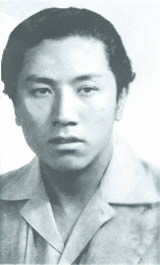Phuntsok Wangyal facts for kids
Quick facts for kids
Phuntsok Wangyal Goranangpa
|
|
|---|---|
| ཕུན་ཚོགས་དབང་རྒྱལ་ 葛然朗巴·平措汪杰 |
|
 |
|
| Leader of the Tibetan Communist Party | |
| In office 1943–1949 |
|
| Preceded by | Position established |
| Succeeded by | Position abolished |
| Personal details | |
| Born | 2 January 1922 Batang, Kham, Tibet |
| Died | 30 March 2014 (aged 92) Beijing, China |
| Nationality | Chinese |
| Political party |
|
Phüntsok Wangyal Goranangpa (born January 2, 1922 – died March 30, 2014) was a very important Tibetan politician. He was also known as Phünwang. He is famous for starting and leading the Tibetan Communist Party.
Phüntsok Wangyal played a big role in how Tibet and China got along in modern times. Sadly, he was arrested by Chinese officials in 1960. He spent 18 years in a high-security prison in Beijing. After he was released, he continued to live in Beijing until he passed away.
Contents
Early Life and Political Beginnings
Phüntsok Wangyal was born in 1922 in a place called Batang. This area was in eastern Tibet, in a region known as Kham. At that time, a Chinese warlord named Liu Wenhui controlled the area.
Phüntsok started his political journey in Nanjing. He attended a special school there in 1939. While at school, he and a few friends secretly created the Tibetan Communist Party. He was asked to leave the school the next year.
From 1942 to 1949, he led a guerrilla movement. This group fought against the Kuomintang, another Chinese political party. The Kuomintang was trying to expand its power in Kham.
Goals for Tibet
Phüntsok Wangyal and his party had two main goals in the 1940s. First, they wanted to get support from young Tibetan students and thinkers. They also wanted to convince powerful families in Central Tibet. Their aim was to bring modern changes and democratic ideas to Tibet.
Second, they fought against the rule of Liu Wenhui. Phüntsok also taught at a school in Lhasa for some time.
Phüntsok's main political dream was for Tibet to be an independent country. He wanted it to be a socialist country. This meant making big changes to Tibet's old social system. He even thought Ladakh should be part of a united Tibet.
Joining the Chinese Communist Party
In 1949, the Tibetan government sent Phüntsok away. He then joined the Chinese Communist Party (CPC). He helped them fight against the Kuomintang.
He later merged his Tibetan Communist Party with the Chinese Communist Party. This happened because the CPC military leaders asked him to. Because of this merger, Phüntsok had to give up his dream of an independent Tibet.
Phüntsok was there during the talks for the Seventeen Point Agreement in 1951. This agreement meant that Tibet became part of China. He played an important role in the CPC's work in Lhasa. He was also the official translator for the young 14th Dalai Lama when he met Mao Zedong in Beijing in 1954 and 1955.
Challenges and Later Life
In the 1950s, Phüntsok was the highest-ranking Tibetan in the Chinese Communist Party. He spoke Chinese well and understood Chinese culture. He was also very dedicated to the CPC's goals. However, his strong efforts to help the Tibetan people made some of his party leaders suspicious.
In 1958, he was placed under house arrest. Two years later, he was no longer seen in public. He was held in a special prison in Beijing for 18 years. During this time, his wife, who was a Tibetan Muslim, passed away while she was also held. All their children were sent to different places.
It wasn't until 1975 that his family learned he was still alive. They found out he had been in a high-security prison. His younger brother was also held in the same prison for 16 years.
Phüntsok was officially cleared of any wrongdoing a few years after his release in 1978. But he had to stay in Beijing and could not have contact with the outside world. Later, he was offered a high position in the Tibet Autonomous Region government, but he said no.
A book about Phüntsok has been published in English. In it, he stressed the importance of understanding the Tibetan people's needs. He believed this was key for peace and unity within China.
He later wrote open letters to Chinese leaders. He suggested that the Dalai Lama should be allowed to return to Tibet. He thought this would help make Tibet more stable. He warned that delaying the "Tibet Problem" could make it much more complicated.
Phüntsok Wangyal passed away on March 30, 2014, in a Beijing hospital.
Published Works
- Liquid water does exist on the moon (1st ed.). Beijing: Foreign Languages Press. 2002. ISBN 7-119-01349-1.
- Witness to Tibet's history (1st ed.). New Delhi, India: Paljor Publications. 2007. ISBN 978-81-86230-58-9.
- (in zh-Hant-HK) 平等團結路漫漫——對我國民族關係的反思. Hong Kong: 田園書屋. 2014. ISBN 978-988-15571-9-3.
See also
 In Spanish: Phuntsok Wangyal para niños
In Spanish: Phuntsok Wangyal para niños

